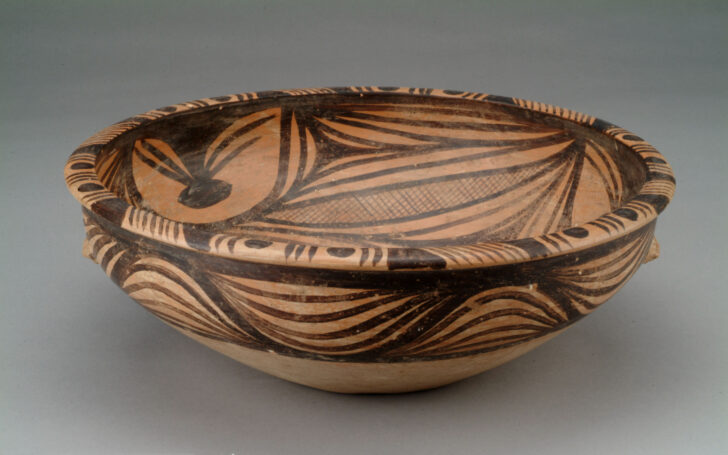Bowl
Chinese

Description
China is unique among world civilizations in having cultural characteristics that can be traced back to Neolithic times—-an age when stone tools were used for farming and bronze weapons and implements were not yet invented. Majiayao culture, which existed from 3800 to 2000 BCE, produced earthenware pottery that fall into four distinct phases, Shilingxia, Majiayao, Banshan, and Macheng. The second phase, Majiayao (ca. 3290-2880 BCE), superbly represented by this bowl, is characterized by bold linear patterns and geometric patterns painted with an energetic brush. While it has not been determined what the abstract forms mean, some have described the fluid brushwork swirling across this bowl’s curving sides as a “flowing water” design. On the interior, the radiating designs are broken up by a curious tadpole-like motif. Two small protrusions on the exterior serve as “handles” for the vessel, which has a burnished surface. [Natsu, please check that it is in fact burnished. I can’t tell from photo.]
People of the second phase of Majiayao culture lived in riverside villages, and made their livelihood by hunting, fishing, and small-scale plant cultivation. Kilns were located just outside the village, but potting does not seem to have been a specialized occupation. There was very little variation in the types of vessels made, and certain shapes remained popular for many centuries.
(Label for UMMA Chinese Gallery Opening Rotation, March 2009)
Subject Matter:
A large basin or bowl the Neolithic Majiayao phase (3100–2600 BCE) of Majiayao Culture from Majiayao, Gansu of the Yellow River Valley in northwestern China. Discovered by Johan Gunnar Andersson in 1921, by the 1980s approximately 60,000 items and 400 kilns had been discovered at Majiayao sites (He Li 1996, 22). The Majiayao phase of this neolithic culture shows more variation of shapes and decorations than the later Banshan or Machang phases. They were found in subterranean graves with conical bases placed into the local loess soil. Despite being placed in the ground, often the entire surfaces of Majiayao phase pots were decorated, however the decoration on the exterior of this bowl only covers half of its surface, while the interior is completely covered. While it is impossible to know the meaning behind this decoration, researchers suggest perhaps the swirling and wavy lines represent the cosmos, swirling water or eddies, along with cross-hatching as fishing nets, of the nearby Yellow River, which was a major source of food.
These bowls are extraordinarily thin and lightweight. Constructed by using the coiling method, they were then paddled and scraped thin, covered in a fine slip, and then painted with mineral pigments before being fired in small, simple updraft kilns. The mineral pigments consisted of iron and manganese oxides to give red, brown and black hues.
Reference:
He, Li. Chinese Ceramics: a New Comprehensive Survey From the Asian Art Museum of San Francisco. New York: Rizzoli, 1996.
Physical Description:
A wide round bowl with an articulated, everted wide rim and a conical lower body on a flat base. It is decorated with wavy linear patterns on the upper half of the exterior, and swirling lines with dots and networks of cross-hatching on the interior. Cross-hatching, curved lines and dots are on the rim.
Usage Rights:
If you are interested in using an image for a publication, please visit https://umma.umich.edu/request-image/ for more information and to fill out the online Image Rights and Reproductions Request Form.